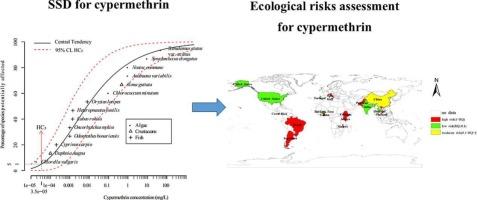Assessment of the ecological risk posed by cypermethrin to surface waters based on a species sensitivity distribution model
IF 4.3
3区 环境科学与生态学
Q2 BIOCHEMISTRY & MOLECULAR BIOLOGY
Comparative Biochemistry and Physiology C-toxicology & Pharmacology
Pub Date : 2025-08-05
DOI:10.1016/j.cbpc.2025.110308
引用次数: 0
Abstract
Cypermethrin, as a type II pyrethroid broad-spectrum insecticide, is often detected in aquatic environments. However, the ecological risk posed by cypermethrin to global surface waters remains uncertain. In this study, the species sensitivity distribution and assessment factor-based methods were used to evaluate the sensitivity of various aquatic organisms to this insecticide, incorporating both acute toxicity and chronic toxicity data. Crustaceans exhibited the highest sensitivity to cypermethrin, whereas algae showed the lowest sensitivity. The acute and chronic hazardous concentrations of cypermethrin affecting 5 % of species (HC5) in freshwater environments were determined to be 9.2 × 10−5 and 3.5 × 10−5 mg/L, respectively. Therefore, it was concluded that cypermethrin is highly toxic to freshwater organisms, in line with previous ecological risk assessments conducted in 12 countries worldwide. Limited data are available on the toxicity of cypermethrin to marine organisms. Existing data suggest a high ecological risk of cypermethrin in the north central coastal zone of Sinaloa, Mexico. Thus, cypermethrin may pose serious ecological risks to aquatic organisms globally and potentially threaten human health.

基于物种敏感性分布模型的氯氰菊酯对地表水生态风险评价
氯氰菊酯是一种II型拟除虫菊酯类广谱杀虫剂,在水生环境中经常被检测到。然而,氯氰菊酯对全球地表水造成的生态风险仍不确定。本研究采用物种敏感性分布和基于评价因子的方法,结合急性毒性和慢性毒性数据,评价了各种水生生物对该杀虫剂的敏感性。甲壳类动物对氯氰菊酯的敏感性最高,藻类最低。经测定,淡水环境中影响5%物种(HC5)的氯氰菊酯急性和慢性有害浓度分别为9.2 × 10−5和3.5 × 10−5 mg/L。因此,结论是氯氰菊酯对淡水生物具有高毒性,与之前在全球12个国家进行的生态风险评估一致。关于氯氰菊酯对海洋生物的毒性的数据有限。现有资料显示,在墨西哥锡那罗亚中北部沿海地区,氯氰菊酯具有较高的生态风险。因此,氯氰菊酯可能在全球范围内对水生生物造成严重的生态风险,并对人类健康构成潜在威胁。
本文章由计算机程序翻译,如有差异,请以英文原文为准。
求助全文
约1分钟内获得全文
求助全文
来源期刊
CiteScore
7.50
自引率
5.10%
发文量
206
审稿时长
30 days
期刊介绍:
Part C: Toxicology and Pharmacology. This journal is concerned with chemical and drug action at different levels of organization, biotransformation of xenobiotics, mechanisms of toxicity, including reactive oxygen species and carcinogenesis, endocrine disruptors, natural products chemistry, and signal transduction with a molecular approach to these fields.

 求助内容:
求助内容: 应助结果提醒方式:
应助结果提醒方式:


